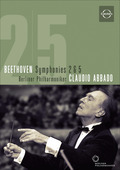Beethoven- Symphonies 2 & 5
Label: EUROARTS Catalog: 2051158 Format: DVD This performance already was praised by Christopher Abbot in Fanfare 33:1 in discussing the complete set, on four DVDs, of Abbado’s Beethoven. Also, see Fanfare 28:6 for Robert McColley’s comments about another volume in this series—one containing the Third and Ninth symphonies. I experienced Yogi Berra-esque déjà vu all over again when I saw the present release, and indeed, I think EuroArts simply has put old wine in a new bottle—or in this case, an older single DVD release in new packaging. That’s not a complaint, though, just an observation. If you missed your first opportunity to acquire this DVD, or if you have not purchased the complete set (and why wouldn’t you, because it’s great?), then here’s another chance. My thoughts about these performances are similar to McColley’s and Abbot’s, so I will not go on at length about their virtues. Here are the main points. First, Abbado approached these symphonies after reviewing new editions by Jonathan Del Mar, which gave him fresh insights into articulation, phrasing, and dynamics. Second, he uses a reduced complement of cellos and double basses in the Second Symphony—four and three, respectively. This has created a less weighty but more distinct sound. Third, all repeats are taken. Finally, tempos are brisk, but not ridiculously so. Indeed, there’s not a self-indulgent bone in their body, which makes Abbado’s Beethoven an excellent “reference set” on both DVD and CD. (Deutsche Grammophon’s audio-only releases are contemporaneous with EuroArts’s DVDs.) Although the earth won’t shake and the skies won’t open, I don’t think those were Abbado’s intentions anyway. Suffice it to say that there’s no lack of excitement and beauty here, and justice has been done to the composer. There’s plenty of gorgeous playing to be heard from the BPO’s players, not just in the slow movement, but throughout. (The site of these concerts was Rome’s Santa Cecilia National Academy.) Sonically, this DVD should please most listeners. I’ve never been in Santa Cecilia so I don’t know what it sounds like, but I feel that the sound on this disc is realistic and not idealized. The camerawork is fluid, and while there is a lot of cutting between various perspectives, it isn’t distracting. In the Fifth Symphony, we are given the option of switching between the usual “concert camera” and “conductor camera”—in other words, looking only at Maestro Abbado during the entire performance. Nothing against Abbado, but I am not sure why anyone would want to do that unless they were in the orchestra, and I am happy to go along with the engineering team’s decisions about visually editing a performance in the traditional way. |












